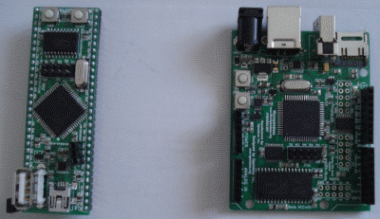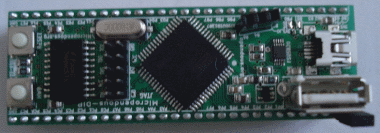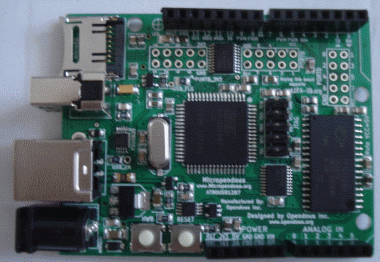The new Micropendous lineup
Much to the chagrin of my friends and family I’m sure, today’s post isn’t going to be about where I am at the moment — to much about Norway will just bore everyone. I will however post two small Norwegian related things. Firstly, a poorly drawn MSPaint comic about walking home yesterday:
Which I’ve entitled “Why I now walk on the beaten tracks instead of estimating snow depth”. The second piece is actually a poem written about me by my (rather talented) Uncle Frank in a Christmas card I received before I left last week:
It’s sunrise around ten, then dawn at about four.
It is winter in Norway, you can’t ask for more.
Now the north pole is nearby, they are all working hard,
They know that it he is coming, the busy elves are on guard.
The arctic circle at Christmas, is a busy scene,
So look out Santa, here comes Dean!
Which I thought too good not to share with everyone.
Now, on to the boring electronics-related stuff. Just a few days before I left for the plane last week I was fortunate enough to receive an unexpected gift from lands far away; new Micropendous stock! Matt over at Micropendous has been more than generous in sending me his new board designs as he makes them, which makes for very fun times on my end playing around with them – and they make great development/test platforms for LUFA, too.
It’s been a while since Matt has produced a new set of boards, but the wait has been totally worth it. This time Matt’s decided to shrink down his range of boards to just two, and value-add the bejeesus out of them instead of going with the barebones boards similar to the Teensy. The new revamped Micropendous lineup contains two boards sporting nearly identical hardware, but vastly different form factors:
What’s most intriguing about these boards isn’t how they are different, but rather, how they are similar. On the left is the new replacement DIP form factor board, which uses an AT90USB1287 microcontroller, fast 16MHz crystal, a USB multiplexer IC (which allows for software controlled switching between the USB device and host plugs, instead of the previous hardware jumper of the older boards), an external 128KB SRAM IC (mounted to the underside) and a MicroSD card reader slot with bidirectional voltage level translator (also mounted to the underside).
The second board is – in my opinion – the most interesting of the two, which contains the exact same schematic as the DIP version in a single-sided form factor, but also sports additional power circuitry to allow for on the fly switching between USB VBUS power and an external DC power source.
So what makes the second board so interesting? Look closer. At first I thought Matt was having a bad layout day, but then I realized; those wackily spaced SIL headers are actually Arduino shield compatible! That’s right – Matt’s now focusing more heavily on his LUFAduino distribution for the board, which combines LUFA, the FreeRTOS operating system and the Arduino library to create what is essentially a native USB Arduino board. This means it opens up LUFA to a whole new audience, and also allows for rapid application development using the billions of Arduino shields and addon libraries already being produced.
Quite frankly, the thought of merging the power of LUFA with the ease of development of Arduino makes me happy in ways and places usually heard in courtroom hearings. This is what the Arduino Uno could have been, if the designers didn’t care much about backward compatibility. Not to say the Uno isn’t a great piece of kit (I received one yesterday while at Atmel, still evaluating it) but I really think Matt’s stumbled onto a great idea. The external DC power input is something I haven’t seen outside the Atmel USBKEY – and since it’s a standard DC jack, it’s even more convenient to use with existing power packs instead of the USBKEY’s two pin header. This thing’s just begging to be made into a USB data logger of some kind.
On a related note, it’s a little hard to capture with my camera, but there’s also something else a bit special about these boards – in fact, so special I now have to put a disclaimer on this review. That’s right; I’m now financially tied to the Micropendous boards! Matt suggested that I start up a hardware royalty program, where USB AVR hardware vendors can pay me a 2% percentage of board sales to fund future development in exchange for listing in the LUFA manual and my website. I think it’s a brilliant idea (hey, who doesn’t like money!) so I’ll be setting up the LUFA Partner page soon. This voluntary program will offer better visibility to partnered USB AVR board vendors that use LUFA. Matt’s Micropendous line is the first entrant into this new program, meaning that for each board sale Matt makes, 2% will go back directly to me.
I’m going to take a few days to sketch out the partner program and set everything up, but if you are interested in joining up please send me an email. Big kudos to Matt for the program proposal. All submissions will be personally vetted by me before being accepted, so that all partnered products will be of a high standard (i.e., no knockoff junk or zero-pin PSGroove “development boards”).
If you’re interested in the new Micropendous boards, Matt’s posting the initial run of boards on his commercial Micropendous site.







Those boards look pretty sweet…this is the kind of thing I was expecting when they first announced Arduino would be using an USB AVR. I’m somewhat disappointed at the Arduino Uno, I feel they missed out on a lot of potential.
[…] This post was mentioned on Twitter by KnurdStuff, Dean Camera. Dean Camera said: New post: The new Micropendous lineup http://bit.ly/gzMjKw […]
Good idea on the hardware royalty program. What kind of listing on your website are you thinking? You should send me some info when you get it all figured out.